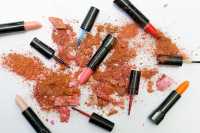
17 Jun Keep Your Up Cosmetics and Out of Sight of of Kids
MedicalResearch.com Interview with:
Rebecca McAdams, MA, MPH CHES
Senior research associate
Center for Injury Research and Policy
Nationwide Children’s Hospital
Columbus, OH
MedicalResearch.com: What is the background for this study?
Response: Cosmetic or personal care products are found in nearly every US home and include items such as nail, hair and skin care products. Many of us use these products daily. Although a cosmetic product may not be harmful when used according to the directions, it is important for parents and caregivers to know that a young child could be seriously injured by these products.
This study found that 64,686 children younger than five years of age were treated in U.S. emergency departments for injuries related to personal care products from 2002 through 2016 – that’s an average of about one child every two hours.
MedicalResearch.com: What are the main findings?
Response: The study found that most injuries from these products occurred when a child swallowed the product (75.7%) or the product made contact with a child’s skin or eyes (19.3%). These ingestions and exposures most often led to poisonings (86.2%) or chemical burns (13.8%).
The study found that the top products that led to injuries were nail care products (28.3%), hair care products (27.0%), skin care products (25.0%), and fragrance products (12.7%). When we looked at specific cosmetic products, nail polish remover was the single product which most frequently caused injuries (17.3%). For all products, children younger than 2 years of age were most commonly injured (59.3%), and they were more than twice as likely to be injured by a cosmetic product compared to children 2-4 years of age.
As the first comprehensive examination of cosmetic-related injuries in children younger than 5 years of age using NEISS data, these results indicate a steady and persistent number of cosmetic-related injuries for children. Children younger than 2 years demonstrated different patterns and injury rates, relative to children aged 2 to 4 years. These findings demonstrate the need for increased efforts and prevention messaging to reduce the burden of cosmetic injuries. Particularly, prevention efforts need to be age-specific to couple developmental milestones with corresponding cosmetic product exposures.
MedicalResearch.com: What should readers take away from your report?
Response: It’s important for parents and caregivers with young children in the home to store all personal care products safely – up, away, and out of sight – in a locked cabinet is best. There are many products on the market to assist with safe storage. A variety of cabinet and drawer locks and latches are on the market which enable most spaces to be made more secure. These products can typically be purchased at grocery stores, mass retailers, drug stores, home improvement stores, hardware stores, and online.
It’s best to store personal care products up (in a cabinet children cannot reach), away (not just sitting on a shelf), and out of sight (in an opaque container or behind an opaque door or drawer). Remember that using child safety products like locks and latches will make storage safer and child-resistant, but no product will make your home completely child-proof.
Parents and child caregivers can help children stay safer by following these tips:
- Up, away and out of sight. Store all personal care products safely: up, away and out of sight – in a cabinet that can be locked or latched is best. Never leave personal care products out unattended and put them away immediately after use.
- Store safely now. It is never too soon to start practicing safe storage. Almost 60% of the injuries in this study were to children younger than 2 years of age.
- Original containers. Keep all personal care products in their original containers.
- Know how to get help. Save the national Poison Help Line (1-800-222-1222) in your cell phone and post it near your home phones.
MedicalResearch.com: What recommendations do you have for future research as a result of this work?
Response: The persistence of cosmetic-related morbidity highlights the need to apply injury prevention strategies to this domain of consumer products. New emphasis needs to be placed on the safe storage recommendations put forward by the American Academy of Pediatrics on bathroom safety, and considerations need to be taken to store these items safely in the bedroom and common areas as well. Of particular relevance is the notion that cosmetic products need to be stored in the same manner as medications: in locked cabinets that are high and out of reach of young hands. Furthermore, not to be underestimated is the role of health care providers in advocating for safe storage of these common products through education at well-child appointments.
I have no financial relationships or potential conflicts of interest relevant to this article to disclose.
Citation:
Cosmetic-Related Injuries Treated in US Emergency Departments: 2002 to 2016
https://doi.org/10.1177/0009922819850492 |
First Published June 16, 2019
[wysija_form id=”3″]
[last-modified]
The information on MedicalResearch.com is provided for educational purposes only, and is in no way intended to diagnose, cure, or treat any medical or other condition. Always seek the advice of your physician or other qualified health and ask your doctor any questions you may have regarding a medical condition. In addition to all other limitations and disclaimers in this agreement, service provider and its third party providers disclaim any liability or loss in connection with the content provided on this website.
Last Updated on June 17, 2019 by Marie Benz MD FAAD


